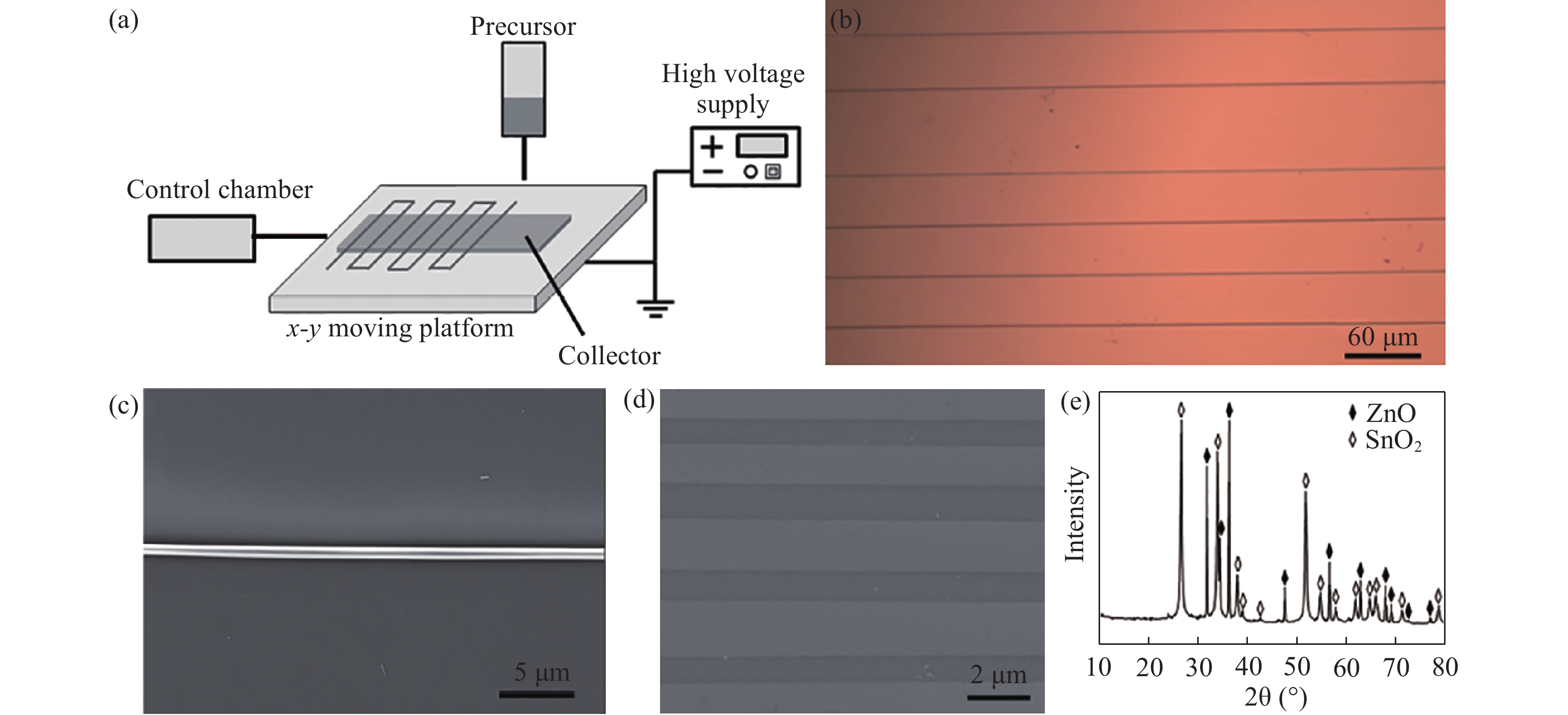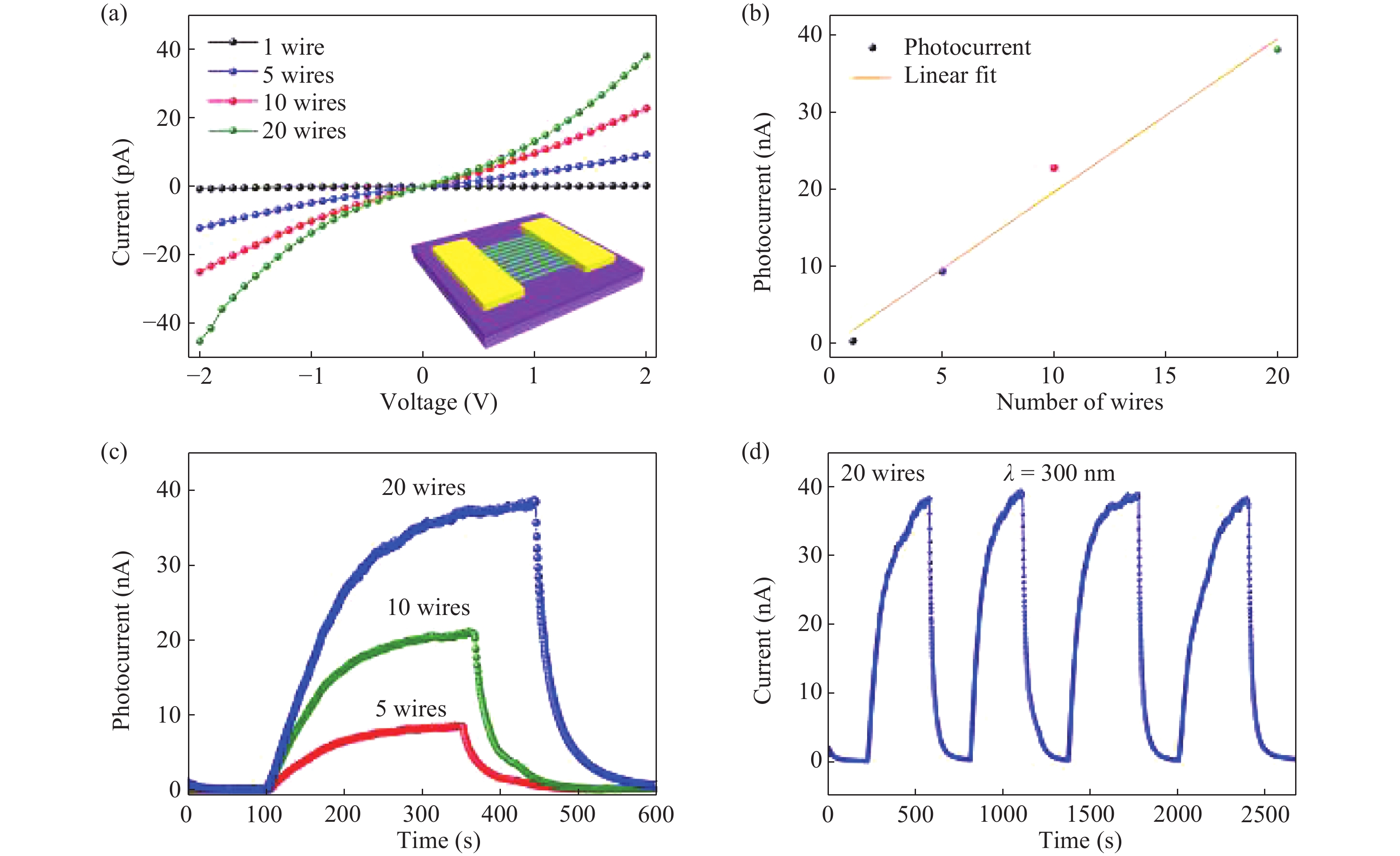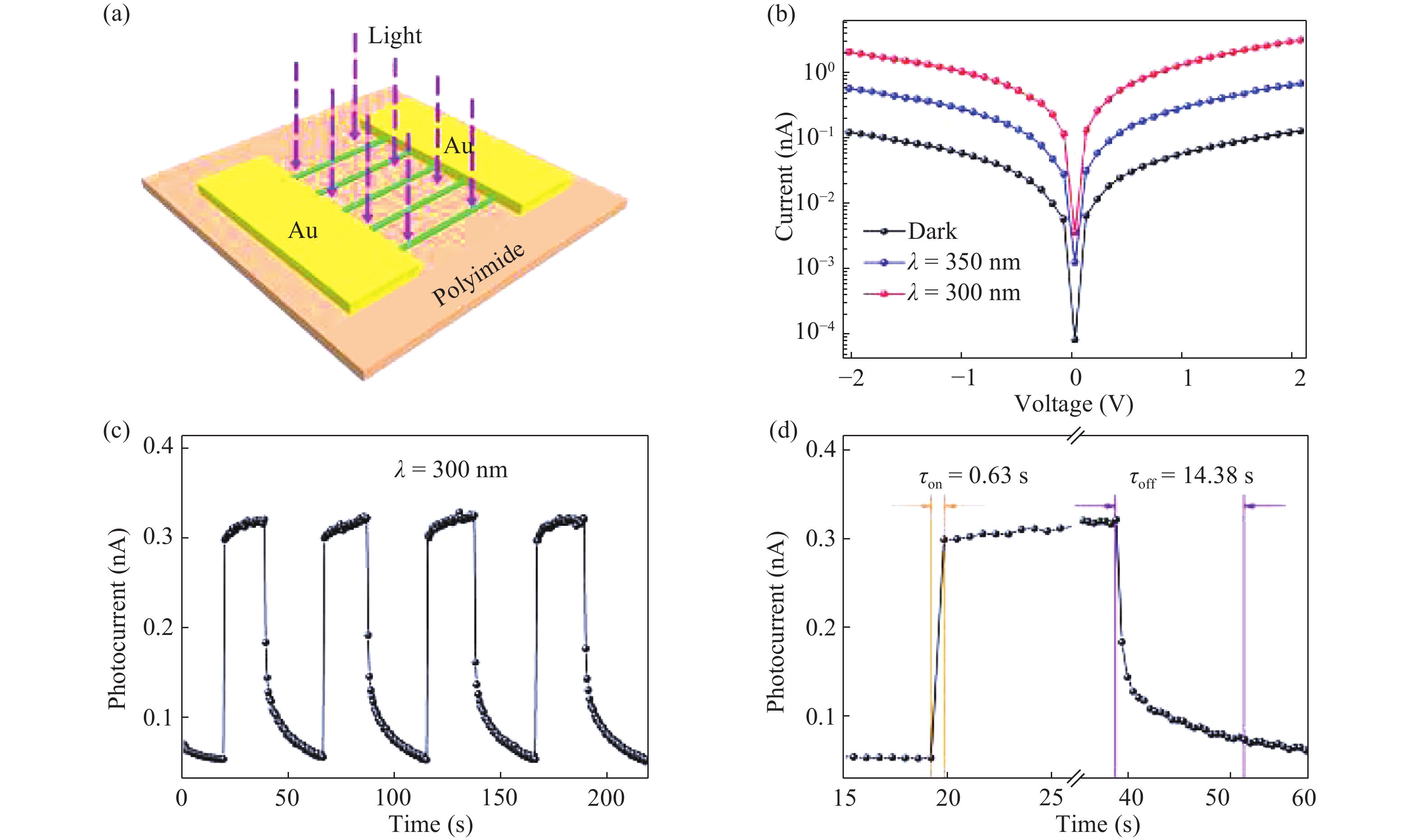| Citation: |
Zheng Lou, Xiaoli Yang, Haoran Chen, Zhongzhu Liang. Flexible ultraviolet photodetectors based on ZnO–SnO2 heterojunction nanowire arrays[J]. Journal of Semiconductors, 2018, 39(2): 024002. doi: 10.1088/1674-4926/39/2/024002
****
Z Lou, X L Yang, H R Chen, Z Z Liang. Flexible ultraviolet photodetectors based on ZnO–SnO2 heterojunction nanowire arrays[J]. J. Semicond., 2018, 39(2): 024002. doi: 10.1088/1674-4926/39/2/024002.
|
Flexible ultraviolet photodetectors based on ZnO–SnO2 heterojunction nanowire arrays
DOI: 10.1088/1674-4926/39/2/024002
More Information
-
Abstract
A ZnO–SnO2 nanowires (NWs) array, as a metal oxide semiconductor, was successfully synthesized by a near-field electrospinning method for the applications as high performance ultraviolet photodetectors. Ultraviolet photodetectors based on a single nanowire exhibited excellent photoresponse properties to 300 nm ultraviolet light illumination including ultrahigh Ion/Ioff ratios (up to 103), good stability and reproducibility because of the separation between photo-generated electron-hole pairs. Moreover, the NWs array shows an enhanced photosensing performance. Flexible photodetectors on the PI substrates with similar tendency properties were also fabricated. In addition, under various bending curvatures and cycles, the as-fabricated flexible photodetectors revealed mechanical flexibility and good stable electrical properties, showing that they have the potential for applications in future flexible photoelectron devices.-
Keywords:
- nanowire,
- photodetector,
- heterojunction
-
References
[1] Sang L W, Liao M Y, Sumiya M. A comprehensive review of semiconductor ultraviolet photodetectors: from thin film to one-dimensional nanostructures. Sensors, 2013, 13: 0482[2] Omnes F, Monroy E, Munoz E, et al. Wide bandgap UV photodetectors: a short review of devices and applications. Proc SPIE, 2007, 6473: 64730E[3] Alaie Z, Nejad S M, Yousefi M H. Recent advances in ultraviolet photodetectors. Mater Sci Semicond Process, 2015, 29: 16 doi: 10.1016/j.mssp.2014.02.054[4] Xiang J, Lu W, Hu Y J, et al. Ge/Si nanowire heterostructures as high-performance field-effect transistors. Nature, 2006, 441: 489 doi: 10.1038/nature04796[5] Hwang Y J, Boukai A, Yang P D. High density n-Si/n-TiO2 core/shell nanowire arrays with enhanced photoactivity. Nano Lett, 2009, 9: 410 doi: 10.1021/nl8032763[6] Huang X, Wang M, Willinger M G, et al. Assembly of three-dimensional hetero-epitaxial ZnO/ZnS core/shell nanorod and single crystalline hollow ZnS nanotube arrays. ACS Nano, 2012, 6: 7333 doi: 10.1021/nn3024514[7] Xu J Y, Ma L, Guo P F, et al. Room-temperature dual-wavelength lasing from single-nanoribbon lateral heterostructures. J Am Chem Soc, 2012, 134: 12394 doi: 10.1021/ja3050458[8] Wang X F, Song W F, Liu B, et al. High-performance organic-inorganic hybrid photodetectors based on P3HT:CdSe nanowire heterojunctions on rigid and flexible substrates. Adv Funct Mater, 2013, 23: 1202 doi: 10.1002/adfm.v23.9[9] Kalisky B, Spanton E M, Noad H, et al. Locally enhanced conductivity due to the tetragonal domain structure in LaAlO3/SrTiO3 heterointerfaces. Nat Mater, 2013, 12: 1091 doi: 10.1038/nmat3753[10] Wang Z R, Wang H, Liu B, et al. Transferable and flexible nanorod-assembled TiO2 cloths for dye-sensitized solar cells, photodetectors, and photocatalysts. ACS Nano, 2011, 5: 8412 doi: 10.1021/nn203315k[11] Soci C, Zhang A, Xiang B, et al. ZnO nanowire UV photodetectors with high internal gain. Nano Lett, 2007, 7: 1003 doi: 10.1021/nl070111x[12] Tsai T Y, Chang S J, Weng W Y, et al. Synthesis, characterization and electrochemical properties of capsule-like NiO nanoparticles. J Electrochem Soc, 2012, 159: J132 doi: 10.1149/2.008205jes[13] Hu L F, Yan J, Liao M Y, et al. Ultrahigh external quantum efficiency from thin SnO2 nanowire ultraviolet photodetectors. Small, 2011, 7: 1012 doi: 10.1002/smll.201002379[14] Lou Z, Li L D, Shen G Z. InGaO3(ZnO) superlattice nanowires for high-performance ultraviolet photodetectors. Adv Electron Mater, 2015, 1: 1500054 doi: 10.1002/aelm.201500054[15] Lou Z, Shen G Z. Flexible photodetectors based on one-dimensional inorganic nanostructures. Adv Sci, 2016, 1: 1500287[16] Wang X F, Liu B, Liu R, et al. Fiber-based flexible all-solid-state asymmetric supercapacitors for integrated photodetecting system. Angew Chem, 2014, 126: 1880 doi: 10.1002/ange.201307581[17] Liu Z, Luo T, Liang B, et al. High-detectivity InAs nanowire photodetectors with spectral response from ultraviolet to near-infrared. Nano Res, 2013, 6: 775 doi: 10.1007/s12274-013-0356-0[18] Chen G, Liang B, Liu X, et al. High-performance hybrid phenyl-C61-butyric acid methyl ester/Cd3P2 nanowire ultraviolet-visible-near infrared photodetectors. ACS Nano, 2014, 8: 787 doi: 10.1021/nn405442z[19] Tian W, Zhang C, Zhai T Y, et al. Flexible ultraviolet photodetectors with broad photoresponse based on branched ZnS–ZnO heterostructure nanofilms. Adv Mater, 2014, 26: 3088 doi: 10.1002/adma.201305457[20] Chong H N, Wei G D, Hou H L, et al. High-performance solar-blind ultraviolet photodetector based on electrospun TiO2–ZnTiO3 heterojunction nanowires. Nano Res, 2015, 8: 2822 doi: 10.1007/s12274-015-0787-x[21] Liu Z, Xu J, Chen D, et al. Flexible electronics based on inorganic nanowires. Chem Soc Rev, 2015, 44: 161 doi: 10.1039/C4CS00116H[22] Zheng Z, Gan L, Zhai T Y. An enhanced UV–Vis–NIR an d flexible photodetector based on electrospun ZnO nanowire array/PbS quantum dots film heterostructure. Adv Sci, 2017, 4: 1600316 doi: 10.1002/advs.201600316[23] Greiner A, Wendorff J H. Electrospinning: a fascinating method for the preparation of ultrathin fibers. Angew Chem Int Ed, 2007, 46: 5670 doi: 10.1002/(ISSN)1521-3773[24] Wu H, Sun Y, Lin D D, et al. GaN nanofibers based on electrospinning: facile synthesis, controlled assembly, precise doping, and application as high performance UV photodetector. Adv Mater, 2009, 21: 227 doi: 10.1002/adma.v21:2[25] Hu L F, Wu L M, Liao M Y, et al. ZnS nanostructure arrays: a developing material star. Adv Mater, 2011, 23: 1988 doi: 10.1002/adma.201004109[26] Shi H P, Cheng B C, Cai Q S, et al. Surface state controlled ultrahigh selectivity and sensitivity for UV photodetectors based on individual SnO2 nanowires. J Mater Chem C, 2016, 4: 8399 doi: 10.1039/C6TC02420C[27] Lou Z. Li L D, Shen G Z, High-performance rigid and flexible ultraviolet photodetectors with single-crystalline ZnGa2O4. Nano Res, 2015, 8: 2162 doi: 10.1007/s12274-015-0723-0[28] Lou Z, Li L D, Shen G Z. Ultraviolet/visible photodetectors with ultrafast, high photosensitivity based on 1D ZnS/CdS heterostructures. Nanoscale, 2016, 8: 5219 doi: 10.1039/C5NR08792A -
Proportional views






 DownLoad:
DownLoad:


















